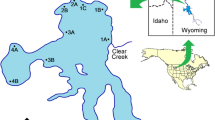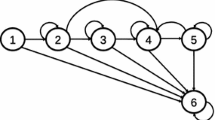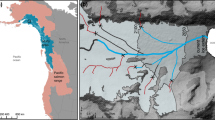Abstract
The storied Yellowstone cutthroat trout (Oncorhynchus clarkii bouvieri; YCT) population of Yellowstone Lake, Yellowstone National Park, Wyoming, USA, has shown a profound and mostly continuous decline since the 1970s despite pristine habitat and vanishing angler harvests. An age-structured Leslie model that had a broad climate index as its only driver (regulating age-0 YCT survival) was Bayesian-fitted to data for a key YCT spawning stock from 1977 to 1992, arguably before predation from an introduced lake trout (Salvelinus namaycush) population (1994 discovery) measurably affected YCT population dynamics. The middle 50% of model fits encompassed 12 of 14 observed spawning populations and nominally excluded the others. Forecasting to 2007 (the final empirical data year) showed the new climate regime largely explained declining YCT numbers, but a growing predation effect became evident soon after lake trout discovery and quickly became the major YCT population driver. The climate effect may have involved the fatal blockage of out-emigrating YCT fry by natural alluvial deposits at spawning tributary mouths in warm, dry years. The previously reported Yellowstone Lake ecosystem shift suggested by the YCT population decline actually began with the 1977 North Pacific Basin climate shift and was only later enhanced by lake trout predation. This study showed identifying and accounting for the overarching population drivers is important to structuring statistical models intended to detect and assess the effects of new and emerging population impacts across historic data sets. Management actions intended to protect these YCT must consider climate effects and probable future climates.






Similar content being viewed by others
References
Arnold JL, Doepke PD, Ertel BD, Koel TM (2017) Fish population responses to the suppression of non-native lake trout. Yellowstone Sci 25(1):60–64
Brooks SP, Roberts GO (1998) Assessing convergence of Markov chain Monte Carlo algorithms. Stat Comput 8:319–335
Caswell H (2001) Matrix population models: construction, analysis, and interpretation, 2nd edn. Sinauer Associates, Sunderland
Easterling DR, Kunkel KE, Arnold JR, Knutson T, LeGrande AN, Leung LR, Vose RS, Waliser DE, Wehner MF (2017) Precipitation change in the United States. In: Wuebbles DJ, Fahey DW, Hibbard KA, Dokken DJ, Stewart BC, Maycock TK (eds) Climate science special report: fourth national climate assessment, vol 1. U.S. Global Change Research Program, Washington, pp 207–230. https://doi.org/10.7930/J0H993CC
Folke C, Carpenter S, Walker B, Scheffer M, Elmqvist T, Gunderson L, Holling CS (2004) Regime shifts, resilience, and biodiversity in ecosystem management. Ann Rev Ecol Evol Syst 35:557–581
Gallucci VF, Quinn TJ II (1979) Reparameterizing, fitting, and testing a simple growth model. Trans Am Fish Soc 108:14–25
Gelman A, Shirley K (2011) Inference from simulations and monitoring convergence. In: Brooks S, Gelman A, Jones G, Meng XL (eds) Handbook of Markov Chain Monte Carlo. Chapman and Hall, Boca Raton, pp 163–174
Gelman A, Carlin JB, Stern HS, Rubin DB (2003) Bayesian data analysis, 2nd edn. Chapman and Hall, Boca Raton
Geweke J (1992) Evaluating the accuracy of sampling-based approaches to the calculation of posterior moments. In: Bernardo JM, Berger JO, Dawid AP, Smith AFM (eds) Bayesian statistics, 4th edn. Oxford University, Oxford, pp 169–193
Graumlich LJ, Pisaric MFJ, Waggoner LA, Littell JS, King JC (2003) Upper Yellowstone River flow and teleconnections with Pacific Basin climate variability during the past three centuries. Clim Change 59:245–262
Gresswell RE, Varley JD (1988) Effects of a century of human influence on the cutthroat trout of Yellowstone Lake. Am Fish Soc Symp 4:45–52
Hare SR, Mantua NJ (2000) Empirical evidence for North Pacific regime shifts in 1977 and 1989. Prog Oceanogr 47:103–145
Hilborn R, Mangel M (1997) The ecological detective: confronting models with data. Princeton University, Princeton
Kaeding LR (2010) Relative contributions of climate variation, lake trout predation, and other factors to the decline of Yellowstone Lake cutthroat trout during the three recent decades. Ph.D. dissertation, Department of Ecology, Montana State University, Bozeman. https://etd.lib.montana.edu/etd/2010/kaeding/KaedingL0510.pdf. Accessed 11 June 2019
Kaeding LR (2012) Are Yellowstone Lake temperatures more suitable to nonnative lake trout than to native cutthroat trout? North Am J Fish Manag 32:848–852
Kaeding LR (2013a) Informative correlations among metrics of Yellowstone Lake cutthroat trout caught by two quantitative methods across three recent decades. North Am J Fish Manag 33:882–886
Kaeding LR (2013b) A climate-based index of historic spawning-stream hydrology. River Res Appl 29:380–388
Kaeding LR, Koel TM (2011) Age, growth, maturity, and fecundity of Yellowstone Lake cutthroat trout. Northwest Sci 85:431–444
Kaeding LR, Boltz GD, Carty DG (1996) Lake trout discovered in Yellowstone Lake threaten native cutthroat trout. Fisheries 21(3):16–20
Kerans BL, Zale AV (2002) The ecology of Myxobolus cerebralis. Am Fish Soc Symp 29:145–166
Koel TM, Bigelow PE, Doepke PD, Ertel BD, Mahony DL (2005) Nonnative lake trout result in Yellowstone cutthroat trout declines and impacts to bears and anglers. Fisheries 30(11):10–19
Koel TM, Mahony DL, Kinnan KL, Rasmussen C, Hudson CJ, Murcia S, Kerans BL (2006) Myxobolus cerebralis in native cutthroat trout of the Yellowstone Lake ecosystem. J Aquat Anim Health 18:157–175
Koel TM, Arnold JL, Bigelow PE, Detjens CR, Doepke PD, Ertel BD, Ruhl ME (2015) Native fish conservation program, Yellowstone Fisheries and Aquatic Sciences 2012–2014, Yellowstone National Park. National Park Service, Yellowstone Center for Resources, Yellowstone National Park, Wyoming, USA, YCR-2015-01. https://www.nps.gov/yell/learn/nature/upload/2012-2014_yellowstone_fisheries.pdf. Accessed 5 Mar 2020
Laine M (2017) MCMC toolbox for MATLAB. https://helios.fmi.fi/~lainema/mcmc/. Accessed 11 June 2019
Mantua NJ, Hare SR, Zhang Y, Wallace JM, Francis RC (1997) A pacific interdecadal climate oscillation with impacts on salmon production. Bull Am Meteorol Soc 78:1069–1079
MathWorks (2016) MATLAB: the language of technical computing. Version 9.0.0.341360 (R2016a). The MathWorks, Natick
Milner NJ, Elliott JM, Armstrong JD, Gardiner R, Welton JS, Ladled M (2003) The natural control of salmon and trout populations in streams. Fish Res 62:111–125
Munro AR, McMahon TE, Ruzycki JR (2005) Natural chemical markers identify source and date of introduction of an exotic species: lake trout (Salvelinus namaycush) in Yellowstone Lake. Can J Fish Aquat Sci 62:79–87
Redmond KT, Koch RW (1991) Surface climate and streamflow variability in the western United States and their relationship to large-scale circulation indices. Water Resour Res 27:2381–2399
Ruzycki JR, Beauchamp DA, Yule DL (2003) Effects of introduced lake trout on native cutthroat trout in Yellowstone Lake. Ecol Appl 13:23–37
Stapp P, Hayward GD (2002) Effects of an introduced piscivore on native trout: insights from a demographic model. Biol Invasions 4:299–316
Steele JH (1996) Regime shifts in fisheries management. Fish Res 25:19–23
Syslo JM, Guy CS, Bigelow PE, Doepke PD, Ertel BD, Koel TM (2011) Response of non-native lake trout (Salvelinus namaycush) to 15 years of harvest in Yellowstone Lake, Yellowstone National Park. Can J Fish Aquat Sci 68:2132–2145
Tronstad LM, Hall RO Jr, Koel TM, Gerow KG (2010) Introduced lake trout produced a four-level trophic cascade in Yellowstone Lake. Trans Am Fish Soc 139:1536–1550
Varley JD, Gresswell RE (1988) Ecology, status, and management of the Yellowstone cutthroat trout. Am Fish Soc Symp 4:13–24
von Bertalanffy L (1938) A quantitative theory of organic growth (inquiries on growth laws II). Hum Biol 10:181–213
Vose RS, Easterling DR, Kunkel KE, LeGrande AN, Wehner MF (2017) Temperature changes in the United States. In: Wuebbles DJ, Fahey DW, Hibbard KA, Dokken DJ, Stewart BC, Maycock TK (eds) Climate science special report: fourth national climate assessment, vol I. U.S. Global Change Research Program, Washington, pp 185–206. https://doi.org/10.7930/J0N29V45
Walters CJ (1986) Adaptive management of renewable resources. McGraw Hill, New York
Acknowledgements
I thank Marko Laine for advice in implementing his MCMC toolbox for MATLAB, Abdul W. Abid for his programming assistance, Paul Stapp for providing variances for the survival probabilities reported in his study, and Gina K. Himes Boor, Nate J. Mantua, Rob W. Van Kirk, and Eric J. Ward for their constructive reviews of preceding versions of this report and suggestions regarding data analyses. This study’s data sets may be obtained from the author.
Author information
Authors and Affiliations
Corresponding author
Additional information
Publisher's Note
Springer Nature remains neutral with regard to jurisdictional claims in published maps and institutional affiliations.
Handling Editor: Télesphore Sime-Ngando.
Rights and permissions
About this article
Cite this article
Kaeding, L.R. New climate regime started and further shaped the historic Yellowstone Lake cutthroat trout population decline commonly attributed entirely to nonnative lake trout predation. Aquat Ecol 54, 641–652 (2020). https://doi.org/10.1007/s10452-020-09765-x
Received:
Accepted:
Published:
Issue Date:
DOI: https://doi.org/10.1007/s10452-020-09765-x




